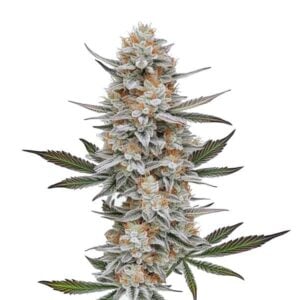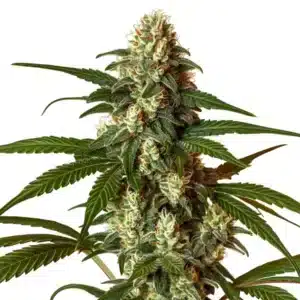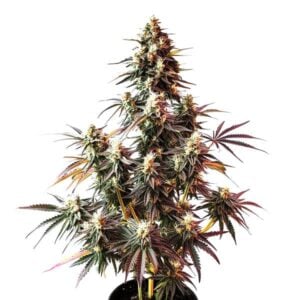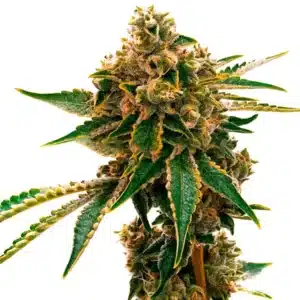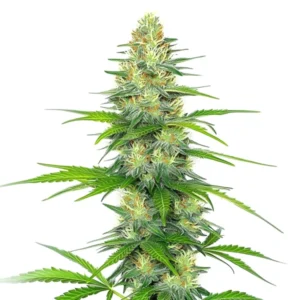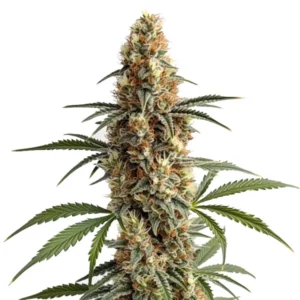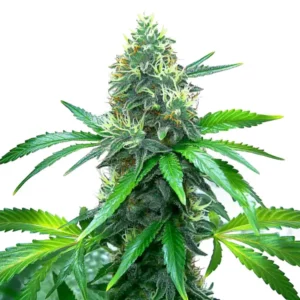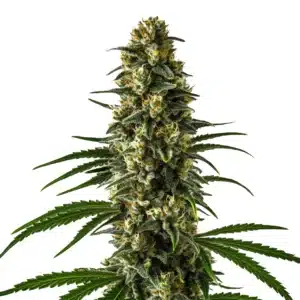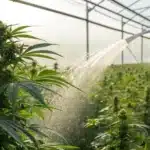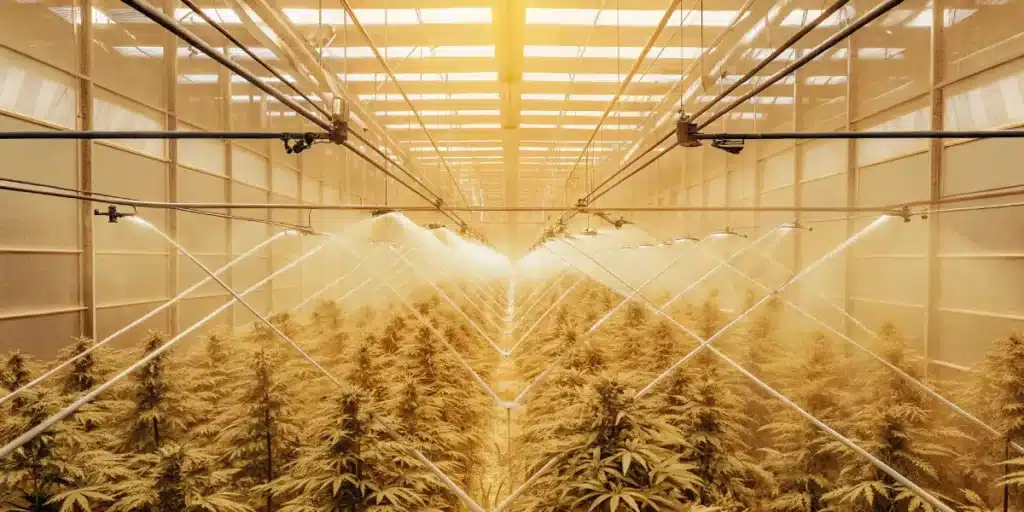
Precision Irrigation Strategies for Cannabis
Precision irrigation strategies for cannabis are transforming how we grow this versatile plant. These strategies focus on delivering the exact amount of water needed for cannabis plants to thrive. By using precision irrigation, growers can maximize their yield while minimizing water waste. This is critical in areas where water is scarce or expensive.
Advanced drip irrigation techniques for cannabis are a popular choice among growers. These systems deliver water directly to the plant’s root zone, ensuring optimal hydration. This method not only conserves water but also promotes healthy root development. Growers can adjust the flow to meet the specific needs of different strains, like the potent Chemdog 4.
Recommended Strains
Chemdog #4
|
|
THC | 18% - 26% (Medium) |
|
|
Type | Feminized |
|
|
Yield | Medium |
|
|
Phenotype | 60% Indica / 40% Sativa |
Gelato
|
|
THC | 27% (High) |
|
|
Type | Feminized |
|
|
Yield | High |
|
|
Phenotype | 50% Indica / 50% Sativa |
Smart irrigation systems for cannabis farming are becoming increasingly popular. These systems use sensors and automated controls to optimize water use. By continuously monitoring soil moisture levels, they ensure plants get just the right amount of water. This reduces the risk of overwatering, which can lead to root rot and other issues. Such systems are ideal for both beginners and seasoned growers alike.
Advanced Drip Irrigation Techniques
Drip irrigation is a cornerstone of precision irrigation strategies for cannabis. It involves a network of tubes and emitters that deliver water directly to each plant. This technique is highly efficient and can be customized for each grower’s specific needs. It’s perfect for maintaining consistent moisture levels, which is crucial for cannabis.
With drip irrigation, it’s easy to control the amount of water each plant receives. This is especially important for strains like Gelato, which may have different water needs compared to other varieties. By adjusting the flow, growers can ensure each strain gets what it needs to flourish.
Advanced drip irrigation techniques for cannabis also allow for the integration of fertilizers and nutrients directly into the irrigation system. This ensures that plants receive a balanced supply of essential nutrients along with water, promoting healthier growth and higher yields. Additionally, these systems can be automated, reducing labor costs and allowing growers to focus on other critical aspects of cultivation.
Furthermore, advanced drip irrigation techniques for cannabis can be easily adapted to different growing environments, whether indoor or outdoor. This flexibility makes them a valuable tool for growers aiming to optimize water use while maintaining high-quality cultivation standards. The precision of these systems also aids in reducing water runoff, further contributing to sustainable farming practices.
Benefits of Drip Irrigation
One of the main benefits of drip irrigation is water conservation. By delivering water directly to the root zone, there’s less evaporation and runoff. This is especially beneficial in dry climates where water is a precious commodity.
Another advantage is the reduction of weed growth. Since water is only delivered to the cannabis plants, weeds have less opportunity to thrive. This means less competition for nutrients and water, allowing cannabis plants to grow stronger.
Drip irrigation systems also enhance plant health by providing a consistent and controlled water supply, which reduces stress on the plants. This steady supply helps in maintaining the plants’ metabolic processes, ensuring robust growth and resilience against environmental stressors. By promoting a stable growing environment, drip irrigation supports the overall vitality of cannabis crops.
Moreover, the use of drip irrigation contributes to the sustainability of cannabis cultivation by minimizing the environmental impact. By reducing water usage and limiting the need for chemical weed control, drip irrigation aligns with eco-friendly farming practices. This sustainable approach not only benefits the environment but also enhances the marketability of the cannabis produce as a responsibly grown product.
Promos & Deals
Optimizing Water Use in Cannabis Cultivation
Optimizing water use in cannabis cultivation is key to sustainable growing practices. It involves using the right amount of water at the right time. This not only supports plant health but also reduces costs and environmental impact.
One way to optimize water use is by implementing cannabis irrigation scheduling for water efficiency. This involves setting a precise schedule for watering based on the plant’s growth stage and environmental conditions. Regularly adjusting the schedule ensures plants receive adequate hydration without excess.
Precision irrigation strategies for cannabis also incorporate the use of weather data and climate information to adjust watering schedules dynamically. By analyzing weather forecasts and real-time climate data, growers can anticipate the water needs of their crops and adjust the irrigation accordingly. This proactive approach minimizes water wastage and enhances the efficiency of water use.
Moreover, optimizing water use in cannabis cultivation involves regular system maintenance and checks to ensure the irrigation equipment is functioning correctly. This includes inspecting pipes, emitters, and sensors for leaks or blockages, which can lead to water loss or uneven distribution. Regular maintenance helps in sustaining the effectiveness of the irrigation system and ensures the long-term success of the cultivation process.
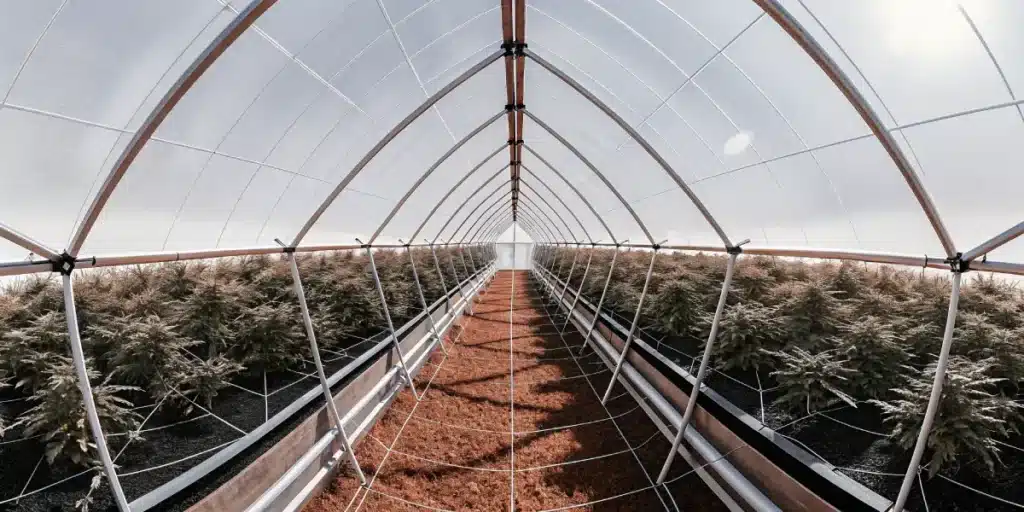
Implementing a Watering Schedule
Creating a watering schedule involves knowing the specific needs of your cannabis strains. For instance, the OG Kush may require different watering intervals than other plants. Factors like temperature, humidity, and plant size also play a role in determining the optimal schedule.
Using technology can simplify this process. Many growers use apps and devices to track and adjust their watering schedules. This allows them to respond quickly to changes in the environment or plant health.
Implementing a cannabis irrigation scheduling for water efficiency not only ensures optimal water use but also aids in predicting future water needs. By analyzing past watering patterns and plant responses, growers can fine-tune their schedules for upcoming growth cycles. This predictive capability helps in planning resource allocation and managing cultivation costs effectively.
Additionally, a well-implemented watering schedule can serve as a foundation for integrating other precision irrigation strategies. For example, combining scheduling with soil moisture monitoring allows for real-time adjustments to the irrigation plan, ensuring that water delivery is always aligned with the plants’ immediate needs. This integration enhances the overall efficiency and adaptability of the irrigation strategy.
Precision Soil Moisture Monitoring
Precision soil moisture monitoring for cannabis plants is an essential component of modern cultivation practices. It involves using sensors to measure the moisture level in the soil accurately. This information is crucial for making informed decisions about watering.
These sensors can be placed at various depths to get a complete picture of the soil’s moisture content. This is particularly useful for large-scale operations, where manual checks would be time-consuming and less accurate.
Precision soil moisture monitoring for cannabis plants provides critical insights that help in maintaining optimal growing conditions. By having access to real-time data, growers can prevent issues related to both overwatering and underwatering, ensuring that the plants receive the exact amount of water needed for healthy growth and development.
Besides to enhancing water management, soil moisture monitoring supports the precision irrigation strategies for cannabis by enabling more accurate fertilizer application. By knowing the moisture levels, growers can better time their nutrient delivery, ensuring that plants receive the maximum benefit from the inputs. This precision in resource application contributes to the overall sustainability and productivity of cannabis cultivation.
How Soil Moisture Sensors Work
Soil moisture sensors work by sending an electrical signal through the soil. The resistance of this signal indicates how much moisture is present. This data is then sent to a central system, which can trigger watering if levels drop too low.
These sensors are compatible with smart irrigation systems for cannabis farming. They ensure that plants receive just the right amount of water, which is crucial for optimal growth and yield.
Soil moisture sensors are integral to precision irrigation strategies for cannabis, as they provide a continuous stream of data that allows for immediate response to changing soil conditions. This responsiveness is crucial in preventing stress on plants due to fluctuating moisture levels, thereby supporting consistent growth and high-quality yields.
Moreover, the integration of soil moisture sensors with other smart irrigation systems for cannabis farming creates a holistic management approach. By combining moisture data with environmental sensors and automated controls, growers can achieve a highly efficient and responsive irrigation system that optimizes water use and enhances plant health across different cultivation setups.
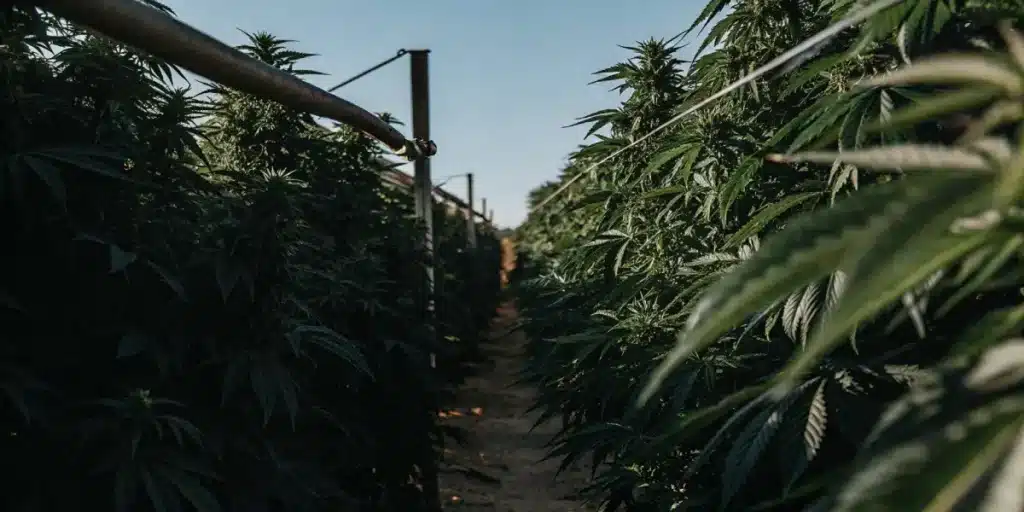
FAQs
What are precision irrigation strategies for cannabis?
Precision irrigation strategies for cannabis focus on providing the exact water needs for each plant. These strategies involve using technology like drip irrigation and soil moisture sensors to optimize water delivery. This ensures plants get the right amount of water, promoting healthy growth and maximizing yield.
These strategies are important for conserving water and reducing costs. They are adaptable to different growing environments and can be customized for various cannabis strains. By using precision irrigation, growers can achieve better results with less effort.
Precision irrigation strategies for cannabis are continuously evolving with advancements in technology. Innovations such as machine learning and artificial intelligence are being integrated into irrigation systems, offering predictive analytics that enhance decision-making processes for growers. This forward-thinking approach ensures that precision irrigation remains at the forefront of sustainable cannabis cultivation.
Incorporating these advanced technologies into precision irrigation strategies not only optimizes water use but also enhances the overall efficiency of cannabis production. By enabling more accurate and data-driven irrigation management, these strategies help growers achieve higher yields and better quality crops while minimizing environmental impact.
How do smart irrigation systems benefit cannabis growers?
Smart irrigation systems for cannabis farming use technology to automate and optimize watering. These systems rely on sensors and controllers to ensure plants receive the right amount of water at the right time. This reduces the risk of overwatering and helps conserve water.
Growers benefit from the convenience and efficiency of these systems. They can monitor and adjust settings remotely, allowing for greater flexibility and control. Smart systems are especially useful for large-scale operations where manual watering would be impractical.
Smart irrigation systems for cannabis farming also offer scalability, making them suitable for both small and large operations. Whether a grower is managing a few plants or an extensive commercial farm, smart systems can be tailored to meet their specific needs and expansion goals. This adaptability ensures that the technology remains beneficial regardless of the scale of cultivation.
Additionally, by integrating smart irrigation systems with other farm management software, growers can achieve a comprehensive view of their cultivation processes. This holistic approach allows for better resource management and improved decision-making, ultimately leading to more successful and sustainable cannabis farming practices.
What is cannabis irrigation scheduling?
Cannabis irrigation scheduling for water efficiency is a method of planning when and how much to water your plants. It takes into account factors like plant size, growth stage, and environmental conditions. A well-designed schedule ensures plants receive adequate hydration without excess.
Scheduling helps prevent issues like under-watering or overwatering, both of which can affect plant health. By sticking to a schedule, growers can optimize water use, saving time and resources in the process.
Implementing a cannabis irrigation scheduling strategy also facilitates the integration of other precision irrigation components, such as soil moisture monitoring and advanced drip irrigation techniques. By coordinating these elements, growers can create a seamless irrigation system that is both efficient and responsive to the plants’ needs.
Moreover, cannabis irrigation scheduling for water efficiency can be enhanced through the use of advanced software tools that provide data analytics and insights. These tools help growers understand plant water demand patterns over time, enabling more precise scheduling and resource allocation. This data-driven approach supports sustainable water use and enhances the overall productivity of cannabis cultivation.
Why is soil moisture monitoring important for cannabis plants?
Precision soil moisture monitoring for cannabis plants provides critical data for making informed watering decisions. By knowing the exact moisture content of the soil, growers can adjust their irrigation practices to meet the plants’ needs.
This monitoring helps prevent overwatering, which can lead to root rot and nutrient leaching. It also ensures plants have enough moisture to support healthy growth, leading to better yields and quality.
Soil moisture monitoring is particularly vital in precision irrigation strategies for cannabis in regions with variable climate conditions. By continuously tracking moisture levels, growers can adapt their irrigation practices to changing environmental conditions, ensuring that the plants remain healthy and productive despite external fluctuations.
Furthermore, precision soil moisture monitoring for cannabis plants contributes to more sustainable water management by allowing growers to apply water more efficiently. This not only conserves water resources but also reduces the overall environmental footprint of cannabis cultivation, aligning the practice with broader sustainability goals.
How can advanced drip irrigation techniques improve cannabis cultivation?
Advanced drip irrigation techniques for cannabis deliver water directly to the plant’s root zone. This targeted approach conserves water and promotes healthy root development. By adjusting the system, growers can provide the right amount of water for each strain.
Drip systems reduce water waste and lower the risk of diseases by keeping foliage dry. They are adaptable to different growing conditions and can be scaled for operations of any size. This makes them an ideal choice for efficient and effective cannabis cultivation.
Advanced drip irrigation techniques for cannabis also enhance nutrient management by allowing for precise control over the application of fertilizers. This targeted delivery ensures that nutrients reach the root zone where they are most needed, improving plant nutrition and growth outcomes.
Besides, these techniques support the implementation of precision irrigation strategies by providing a reliable infrastructure that can be easily integrated with other technologies, such as soil moisture sensors and smart irrigation systems. This comprehensive approach not only optimizes water use but also enhances the overall efficiency and productivity of cannabis cultivation.


